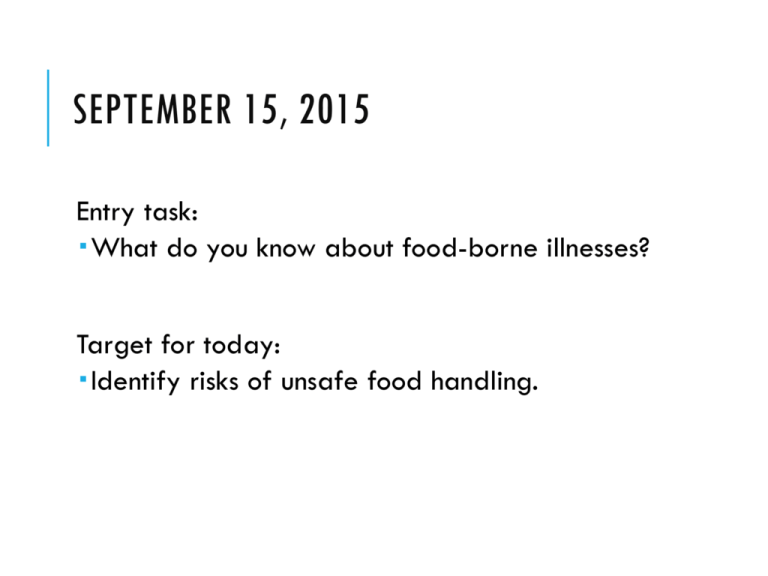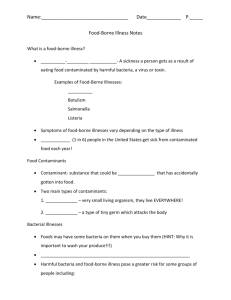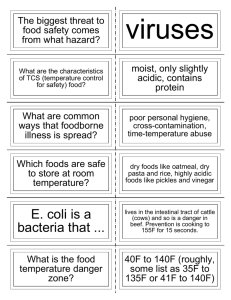FBI PPT
advertisement

SEPTEMBER 15, 2015 Entry task: What do you know about food-borne illnesses? Target for today: Identify risks of unsafe food handling. COMING UP… Today We will go over food-borne illnesses Discuss upcoming Food-Borne Illness Project Wednesday Scary Video Thursday - Friday Computer lab YESTERDAY WRAP UP Handwashing activity REVIEW: HOW LONG SHOULD YOU SCRUB YOUR HANDS? How did it go? What did you notice? Will it change the way you wash your hands? IT MUST HAVE BEEN SOMETHING I ATE! Many people get sick each year from the food they eat. They may have diarrhea, vomiting, an upset stomach, fever, or cramps. They often think they have the flu, but the real problem is food-borne illness caused by bacteria in the food or viruses transmitted to food eaten a few hours or several days ago. WHAT IS A FOOD-BORNE ILLNESS? Food-Borne Illness - A sickness a person gets as a result of eating food contaminated by harmful bacteria, a virus or toxin. Examples of Food-Borne Illnesses: E-coli Botulism Salmonella Listeria Symptoms of food-borne illnesses vary depending on the type of illness 48 MILLION (1 in 6) people in the United States get sick from contaminated food each year! FOOD CONTAMINANTS Contaminant- substance that could be harmful that has accidentally gotten into food. Two main types of contaminants: 1. Bacteria – very small living organism, they live EVERYWHERE! 2. Virus – a type of tiny germ which attacks the body BACTERIAL ILLNESSES • Foods may have some bacteria on them when you buy them (HINT: Why it is important to wash your produce!!!) • Most people can handle small amounts of harmful bacteria • Harmful bacteria and food-borne illness pose a greater risk for some groups of people including: infants, pregnant women, older adults and people with impaired immune systems BACTERIAL ILLNESSES [CONTINUED] • Symptoms may appear 30 minutes or many days after eating contaminated food • Common symptoms are: abdominal cramps, diarrhea, fatigue, headache, fever and vomiting • Typically last for a few days, but can last a week or longer VIRAL INFECTIONS • Cause about one half (50%) of the cases of food-borne illness • Food-borne viral illnesses usually last 1 – 3 days • Symptoms similar to bacterial illness HOW ARE FOODS CONTAMINATED? Cross contamination! – occurs when bacteria or a virus on one food/person is transferred to another food Three main ways cross contamination can occur: 1. Food to Food 2. Equipment to Food EXAMPLES? 3. People to Food OTHER WAYS FOODS ARE CONTAMINATED • Contaminated while growing • Contaminated during processing (slaughter or washed with bad water) • Food left out, unrefrigerated or stored improperly • Food not cooked thoroughly! • Inadequate HANDWASHING! (see, there it is again) LET’S PLAY A GAME… Decide if the following statements are: FBI FEAR ( Unsafe ) or IN THE CLEAR ( Safe ) FBI FEAR or IN THE CLEAR Use same cutting board and same knife to cut fresh vegetables and raw meat? Safe or unsafe? Why? FBI FEAR or IN THE CLEAR Use different cutting board and same knife to cut fresh vegetables and raw meat? Safe or unsafe? Why? FBI FEAR or IN THE CLEAR Is it ok to store raw chicken on the top shelf of a refrigerator with other produce and foods underneath on a separate shelf as long as the chicken is in a sealed bag? Safe or unsafe? Why? FBI FEAR or IN THE CLEAR Touching raw meats and then preparing vegetables without washing hands between tasks Safe or unsafe? Why? FBI FEAR or IN THE CLEAR Using a wet washcloth to clean off an area where raw meat was placed and the washing the rest of the counter Safe or unsafe? Why? FBI FEAR or IN THE CLEAR Using a clean knife to cut open a package of raw hamburgers and then cutting the sandwich you made for lunch? Safe or unsafe? Why? FBI FEAR or IN THE CLEAR Using the restroom in between cooking tasks and not washing your hands before returning to cooking. Safe or unsafe? Why? FBI FEAR or IN THE CLEAR Leaving your raw chicken on the counter to thaw all day while you are at school Safe of Unsafe? Why? REMEMBER HOW BACTERIA AND VIRUSES SPREAD! Cross Contamination: Food to food Equipment to food People to food Not washing hands Improper ways of storing food Not cooking to correct temperature COOK THOROUGHLY! Use meat thermometer to check temperatures. Always keep hot foods hot and cold foods cold. HANDLE FOOD PROPERLY Prepare foods as directed and properly clean them. Clean your hands, utensils and workspace before and during cooking What are things you should remember when preparing foods? i.e., fruits, vegetables, meats such as chicken, beef, dairy products? WHAT CONDITIONS ENCOURAGE BACTERIA TO GROW? Oxygen Moisture Warm Temperature STORE FOOD PROPERLY Store food at correct temperatures. Know the Danger Zone for certain foods! The Danger Zone is the temperature range of 40° - 140° F. where certain foods could begin to develop harmful bacteria. Don’t keep these foods longer than 2 hours at room temperature. What foods should not be kept in the Danger Zone for too long? PROPER FOOD STORAGE Think about the refrigerator… Store foods ready to eat near the top and RAW foods on the bottom WHY? FIGHT BAC! By following these steps you can avoid food borne illnesses What does this mean? BACTERIA CONTROL TABLE 212 boiling point of water 165-212 most bacteria destroyed by cooking temperatures 140-165 warm temperatures prevent growth but some bacteria surive 120-140 some bacterial growth may occur and many can surrive in this range 40-145 DANGER ZONE with rapid growth of bacteria and production of toxins. Food should move through this temperature range within 2 to 3 hours§ to avoid spoilage. 40-60 some growth of food poisoning bacteria may occur 32-40 cold temperature slows the growth of spoilage causing bacteria 0-32 Freezing temperature, bacterial growth stopped but many can still survive and become active and dangerous as the temperature increases during defrosting. FOODBORNE ILLNESS BROCHURE Meet in lab tomorrow! Choose partners wisely. FEBRUARY 22, 2008 Entry task: What food borne illness did you choose? Why did you choose that particular food borne illness? Target for today: Choose reliable and important information to appear on your brochure.





